WordPress web developers everywhere have an adage, “Update WordPress often!” But is it really such a big deal?
When you ask, they may say, “Yes, yes it is a big deal and no, it’s not negotiable.”
Why? The short end of it is that it’s important for security, performance, bug fixes, compatibility and applying new features and improvements to your website.
Unfortunately, hearing (or reading!) this answer just raises more questions. Not to worry!
Today, I’ll share why keeping WordPress updated is critical to your website, what needs to be updated and when as well as a couple of ways you can stay updated.
What’s Update Got to Do With It?
What’s all the fuss really about? I mentioned earlier that updates are crucial for WordPress sites for security, bug fixes, compatibility and features.
While they’re all important points, it’s not clear why so let’s take a look at the reasons in detail.
Reason #1: Security
The WordPress platform itself is secure. It has a security team working diligently to make sure of it.
In fact, since its earliest version was released, over 2,450 security issues have been fixed. Sometimes, it took less than 40 minutes until sites everywhere were saved from hackers by receiving the security patch.
Despite many instances of hacked sites, the WordPress platform (core) is secure and you should stop worrying about it. Not only because a security team is working on fixing vulnerabilities on a regular basis, but because 31.5% of sites are hacked due to not updating their outdated version of WordPress, according to WP White Security.
You read that right. You can avoid many attempts made by hackers to infiltrate your site if you keep your site updated to the latest version. The reason for this is that security fixes are included in WordPress core updates.
While there are other important reasons to keep your site updated, security is definitely on the top of the list.
For details, check out The Ultimate Guide to WordPress Security.
-

WordPress is secure if you keep it up to date.
Reason #2: Bug Fixes
On a similar note, it’s also important to update your site regularly because bug fixes are also included in updates.
In a perfect world, there wouldn’t be any bugs in software or WordPress for that matter, but the reality is no matter how much of an expert you are at programming, web developing or in WordPress, it’s virtually impossible for anyone to write code that’s free from bugs.
This isn’t because every developer is terrible, it’s just the nature of coding. You could write code that hundreds of other experts review and audit and still be left with bugs.
Writing code is complex and there are so many variables and options, no one can possibly foresee every possible bug that could arise, especially when writing an error is so incredibly easy to do that’s it’s inevitable.
On the bright side, the WordPress core, and most of the plugins and themes that are available are tested to catch as many bugs as possible. It’s also possible to report errors to the developers, which is an option many users take. Once the bugs are found, they can be fixed and those patches are released in updates.
Reason #3: Compatibility
Another reason why keeping WordPress up to date is so essential is for compatibility.
What this means is essentially making sure all the plugins, themes and scripts you use work well with each other as well as with WordPress. If nothing breaks and everything on your site works as expected, they can be considered compatible with each other and with WordPress.
On the other hand, if you install a plugin, for example, and your site or your theme breaks, there’s a compatibility issue.
It may be important to note that this doesn’t apply for minor styling issues such as if a plugin adds a button to your site where its colors don’t match with the theme you’re using or it’s on the left of the page instead of centered.
A true compatibility issue occurs when something breaks and is rendered unusable. Sometimes the very plugin or theme you install could be the one that malfunctions and other times, something else breaks.
Similar to the other reasons mentioned above, fixes for compatibility issues are also included in updates. If you don’t update your site, you aren’t going to receive the fixes.
Keep in mind that while you may not be currently affected by a compatibility issue, it could suddenly become a harsh reality when you try to work on your site, or install a plugin or theme.
If you use a plugin that isn’t compatible with the version of WordPress you’re using, for example, your site could break as soon as you click to activate the plugin.
The WordPress.org plugin repository displays the compatibility of each plugin with the WordPress core, but it can often be easy to miss when you’re focused on completing a task for your site. Many premium plugins or themes also may not make this information easily accessible.
While it’s important to check if a plugin or theme is compatible, it’s also important to keep them updated even if everything seems fine at the moment. Like a volcano, you never know what’s brewing under the surface of your site. Compatibility fixes are often included in plugin and theme updates so it’s important to apply them.
Reason #4: Features and Improvements
So far, I’ve covered many reasons to update that have to do with the overall health of your site, but there’s a reason to stay updated that doesn’t sound quite as melodramatic. In fact, it’s a lot more exciting.
New features and improvements are added to updates for plugins, themes, scripts and the WordPress core all the time. When you update them, you apply these benefits to your site.
Sometimes these updates make your site easier to use or load faster and other times, you get so many new features, it’s almost as though you completely upgraded your site or whatever it is that you updated whether it’s a plugin, theme or WordPress itself.
There could also be many other kinds of benefits under the hood such as optimizations in the code to make the plugins, theme or your site perform better even though you may not notice it immediately. There could also be foundations that were added to pave the way for exciting new improvements in the future.
With all the benefits you could add to your site, it’s a no brainer to take the time and keep it updated.
-
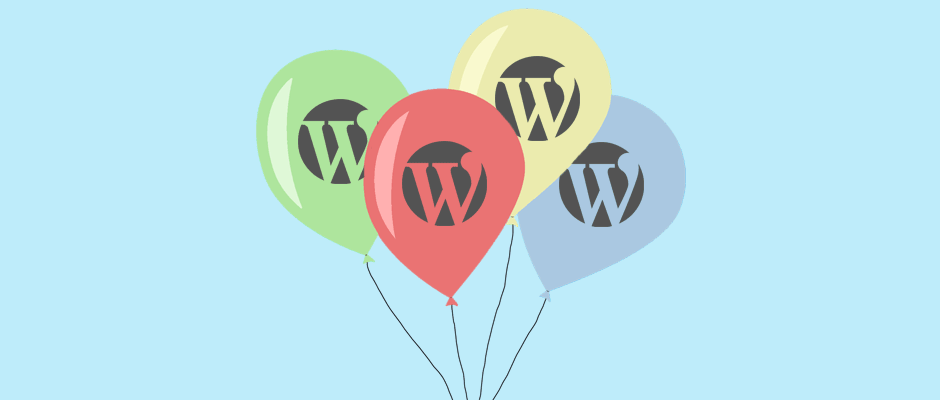
WordPress updates can bring many new and valuable features and improvements.
Welcome to the Jungle
By now, you know that keeping WordPress updated is important, but there’s a caveat. While updates can bring many fixes, features and improvements to the table, they could also break your site.
The main reason for this that there’s a compatibility issue. Since the WordPress core is updated regularly, some developers may struggle to keep up and make sure that their plugins or themes are compatible with the latest version. This can particularly be an issue with free plugins since they’re submitted and maintained on a volunteer basis.
This doesn’t mean you shouldn’t update your site because there’s a way to prevent this from happening: test updates before you apply them to your site.
I Can’t Make You Update Me
You can test updates by creating a staging site, which is a copy of your site, but separate from it so that you can test updates without your public-facing site being affected.
Similarly, you can create a local environment, which is the same thing, but with the notable exception of being on your computer using a virtual server rather than a live one, and can’t be accessed with a browser and an internet connection.
For details, check out The Perfect Workflow for Updating WordPress without Errors.
This is all well and good, but when should you test and update your site? Ideally, you would complete both steps as soon as an update rolls out, though, that’s not always practical.
It’s difficult to have time to stay on top of every single update your site needs, especially when they happen often and at any time.
On top of that, there could be an update for WordPress available that could render a compatibility issue with a plugin or theme you’re using as mentioned earlier. The reverse could also happen where a plugin or theme update breaks the WordPress core.
One of the ways you can manage this is by waiting a little while after a major WordPress core update becomes available. As soon as you see many other updates pop up for your plugins and themes, you can start testing all those updates at once, then apply them all at the same time if all goes well.
Keep in mind that security updates should be applied as quickly as possible to help prevent your site from getting hacked.
Now that you have an idea of when to update your site, what kind of updates do you need to worry about?
Here’s the skinny on what needs to be updated on your site:
- The WordPress core
- Plugins
- Themes
- Scripts
Those are all bits of software you need to keep an eye on to watch for updates when they become available.
Walk (Er, Update) This Way
There are a couple main ways you can update your WordPress site: manually and with a maintenance plan.
It may be important to note that you should create a full backup of your site before you apply any updates. For details, check out the WordPress Codex pages: WordPress Backups and Updating WordPress.
Manually Updating WordPress
To update your site manually, log in and go to Dashboard > Updates. You can also click the update icon at the top of your admin dashboard.
-
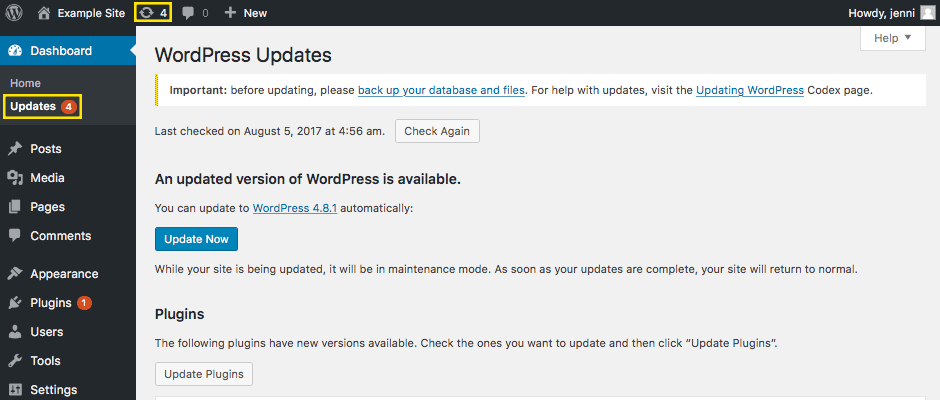
The WordPress updates page for an example site.
You can quickly tell if there are updates available because a number is displayed beside the Updates menu link or the icon at the top, in the admin toolbar. This represents the number of updates that are ready to be applied.
If the WordPress core needs to be updated, you would see the following message to let you know:
“An updated version of WordPress is available.”
After creating a full backup of your site, you can update WordPress by clicking on the Update Now button.
Below the WordPress core update notifications are plugins and themes that also need updating. If you don’t see any listed, then they’re all up to date. Otherwise, you can update the plugins and themes that are installed on your site.
Updating Plugins Manually
To update a plugin, click on the checkbox next to each plugin you want to update or on the Select All checkbox at the the top of the list to update them all at the same time.
-
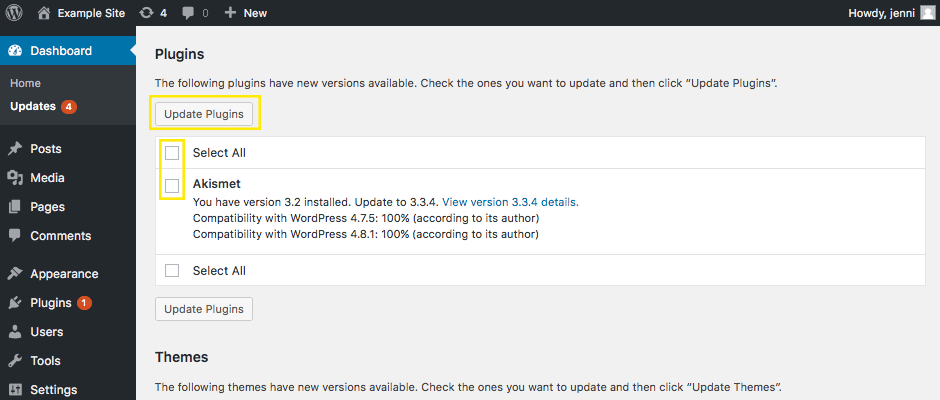
Select one or all of the plugins you want to update, then click Update Plugins.
Next, click the Update Plugins button at the top or bottom of the list to update the plugins you selected.
Once you do that, you’re redirected to a page the automatically populates with details regarding the update process.
When it’s all done, you should see a message to let you know that says, “All updates have been completed.”
-
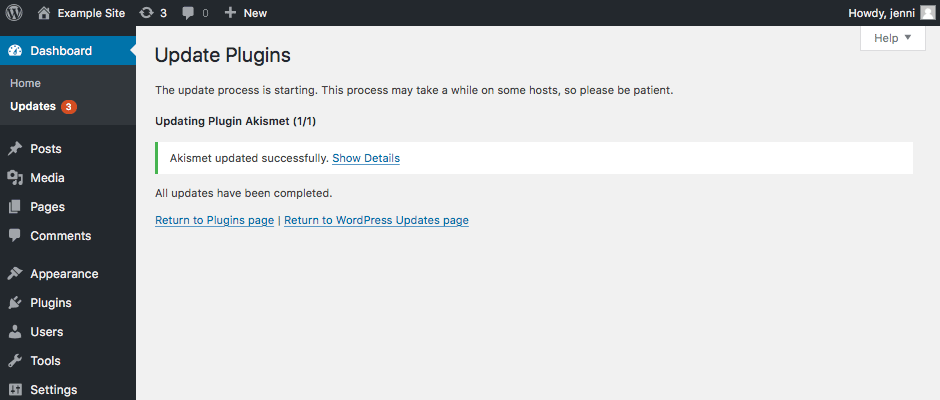
When the plugin updates have finished, you should see a message to let you know.
You can click the Return to WordPress Updates page once you see that notice to update your themes.
Updating Themes Manually
Manual theme updates work the same way as plugin updates. You can click the checkbox next to each theme you want to update. If you want to update them all, you can click the Select All checkbox at the top of the list. Then, click one of the Update Themes buttons.
-
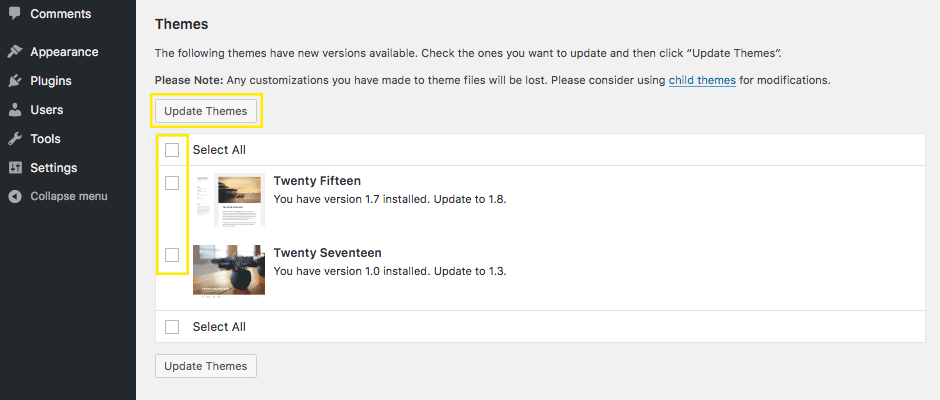
You can update your themes in much the same way as you would plugins.
Next, you’re redirected to a page where you can see how your updates are coming along in real time.
When your updates are finished, you should see the same “success” message to let you know.
-
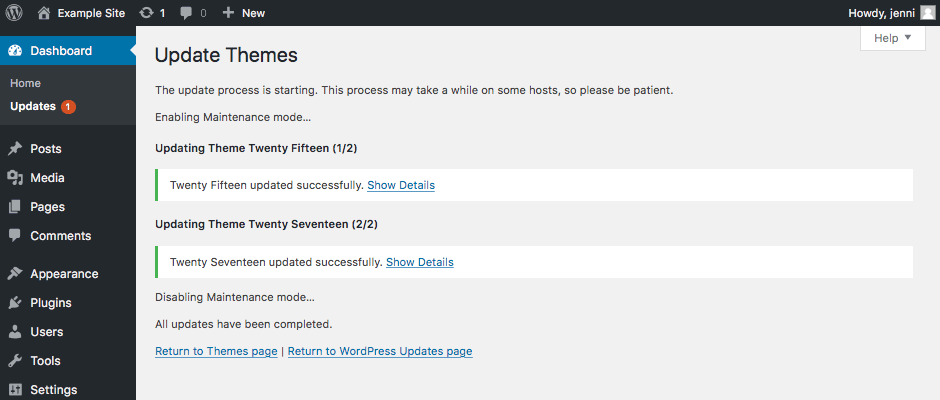
The same message appears when updates are complete for multiple plugins or themes.
It may be important to note that if you’re updating more than one plugin or theme, you may also see a line on the Update Plugins or Update Themes page that says, “Disabling maintenance mode.” This is important because if it doesn’t display when updating multiple plugins or themes at the same time, you have encountered an error.
Fortunately, it can be fixed in a flash. For details, check out WordPress Maintenance Mode: How Do I Get Out of It?
Automagically Update Everything
Updating WordPress, plugins and themes can quickly become tedious and time-consuming. Updates become available all the time and it can be difficult (not to mention exhausting!) to constantly keep yourself up-to-date on WordPress and every single plugin and theme you have installed.
While you could sign up for various WordPress newsletters, it’s not a guarantee that WordPress core updates are mentioned as soon as they’re ready. This goes double for plugins and themes, especially because there are over 50,000 plugins and thousands of themes on the WordPress.org website alone.
The sheer volume of plugins and themes available makes it next to impossible to stay on top of the latest news and updates.
Unless you have loads of time on your hands or you can stay on the cusp of every single update as it rolls out, it’s much easier and more reliable to get a maintenance plan from a WordPress developer or reputable WordPress maintenance and support company.
Maybe I’m Amazed at the Way I Really Need You
If you have a WordPress site, you absolutely need to keep it updated regularly and now you know why. You also know why it’s not negotiable.
You can update WordPress and all your plugins and themes manually, but your best bet is a reliable maintenance plan from a WordPress developer or reputable WordPress maintenance and support company.
Do you keep your WordPress site up-to-date or do you wish you could? What are your concerns about updates? Feel free to share your experience in the comments below.
Read other posts about:
Leave a Reply
Discover your innate talents and embrace them as the foundation to personal and business success. Walk away with personalized tips to help you overcome the mental hurdles unique to your brand builder personality.
What’s your brand builder personality?
Take the quiz
Leave one here
Comments